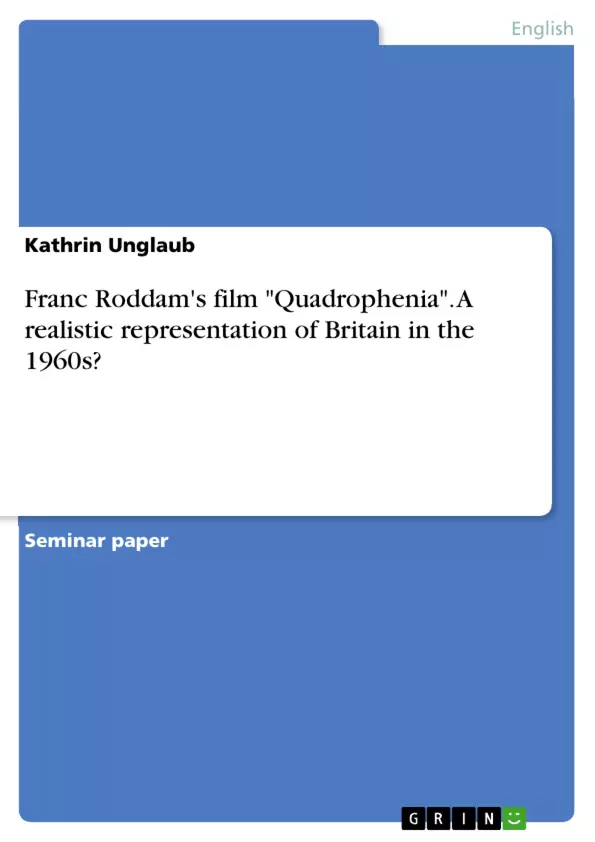The British movie "Quadrophenia" directed by Franc Roddam and released in 1979, picks youngsters’ identity problems from the working class in Britain in the sixties out as a central theme. It is based on the rock opera of the same name by the British band ‘The Who’. The film is quite interesting to watch, especially as a young person, because after all the then-problems still affect today’s youth. It is hard for a young person to find his/her position in society and too many influences from the outside world can distract you from achieving what you aim for in life. In the first part of this term paper I am going to describe the mood of the sixties in England, when the story of the young London Mod James Michael Cooper takes place and important changes during this decade will be mentioned. Besides, two subcultures will be presented: the Teddy Boys, as the beginning of youth movements in England in 1950 and the Rockers, the Mods’ enemies. In the second part of this thesis, I am going to characterise the protagonist of the film "Quadrophenia" in detail. Jimmy’s outward appearance will be described as well as his state of mind. Furthermore, the rivalry between Mods and Rockers will be analised. The members of both subcultures differ not only from their outward appearance but as well in their taste of music and lifestyle which led to riots between 1964 and 1966 between Mods and Rockers, especially at weekends in seaside resorts like Brighton, Margate, Clacton and Hastings.
Table of Contents
- Introduction
- Great Britain in the sixties
- The Swinging Sixties
- Teddy Boys
- Rockers
- The film QUADROPHENIA
- Jimmy, the Mod
- Jimmy's quadrophenia
- The seaside clashes between Mods and Rockers
- Conclusion
Objectives and Key Themes
The main objective of this paper is to analyze the British film QUADROPHENIA, released in 1979, and examine whether it accurately portrays Britain in the 1960s. The film, based on the rock opera by The Who, focuses on the identity struggles of working-class youth in the era. This paper explores the film's portrayal of the Swinging Sixties, the youth subcultures of Teddy Boys and Rockers, and the protagonist Jimmy's experiences as a Mod.
- The social and cultural changes of the Swinging Sixties in England
- The emergence and characteristics of youth subcultures like Teddy Boys and Rockers
- The identity crisis of working-class youth in the 1960s
- The conflict between Mods and Rockers and its portrayal in QUADROPHENIA
- The film's exploration of the protagonist Jimmy's personal struggles and identity
Chapter Summaries
- Introduction: The paper introduces the film QUADROPHENIA and its central theme of youth identity problems in 1960s Britain. The author highlights the film's relevance to contemporary youth and the challenges of finding one's place in society.
- Great Britain in the sixties: This chapter provides an overview of the Swinging Sixties in England, emphasizing the social and cultural shifts that took place following World War II. It also introduces the Teddy Boys and Rockers as significant youth subcultures of the 1950s and 1960s.
- The Swinging Sixties: This section examines the impact of the Abortion Act, Sexual Offenses Act, and Divorce Act, which brought about a more "permissive society" in the 1960s. The chapter also highlights the role of the contraceptive pill, the emergence of fashion icon Mary Quant, and the rise of popular music, particularly The Beatles and The Rolling Stones.
Keywords
This paper focuses on the portrayal of 1960s Britain in the film QUADROPHENIA. Key topics include the Swinging Sixties, youth subcultures, identity formation, the conflict between Mods and Rockers, and the protagonist's personal struggles.
- Citation du texte
- Kathrin Unglaub (Auteur), 2015, Franc Roddam's film "Quadrophenia". A realistic representation of Britain in the 1960s?, Munich, GRIN Verlag, https://www.grin.com/document/319761



